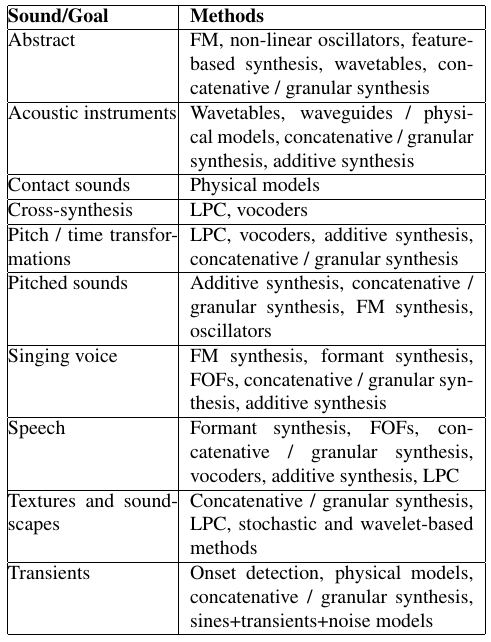Digital Synthesis: Applications
Applications
While every digital sound synthesis approach stands for itself due to its unique characteristics, they all come with inherent strengths and limitations with regard to specific tasks and applications. [Fig.1] shows a list of synthesis goals with suitable approaches by Misra et al. (2009). In general, frequency-domain methods are less suited for time-critical tasks, involving transients and textures. Also, the table in Fig.1 suggests the versatility of granular and concatenative synthesis.

- Fig.1
-
Synthesis goals and suitable approaches (Misra et al, 2009)
Many methods for sound synthesis - analog or digital - have gained their status as an indipendent musical instrument, with characteristic sound properties. Some shaped the development of popular music and spawned new musical genres. This includes sampling - with a close link to rap music, subractive synthesis in many ways and as backbone of techno music, and FM synthesis - with the DX7 literally playing a part in most 1980s pop hits. Such influential synthesizers have again been synthesized. Virtual analog - also analog modeling - emulates vintage subtractive synthesizers in hard- and software and software synthesizers simulate classic FM synthesizers.
References
2011
- John Chowning.
Turenas: the realization of a dream.
Proc. of the 17es Journées d’Informatique Musicale, Saint-Etienne, France, 2011.
[details] [BibTeX▼]
2009
-
Bilbao, Stefan.
Numerical Sound Synthesis.
Wiley Online Library, 2009.
ISBN 9780470749012.
doi:10.1002/9780470749012.
[details] [BibTeX▼] - Ananya Misra and Perry R Cook.
Toward Synthesized Environments: A Survey of Analysis and Synthesis Methods for Sound Designers and Composers.
In Proceedings of the International Computer Music Conference (ICMC 2009). 2009.
[details] [BibTeX▼] - Tae Hong Park.
An interview with max mathews.
Computer Music Journal, 33(3):9–22, 2009.
[details] [BibTeX▼]
1991
- Julius O. Smith.
Viewpoints on the History of Digital Synthesis.
In Proceedings of the International Computer Music Conference, 1–10. 1991.
[details] [BibTeX▼]
1988
- Miller S. Puckette.
The patcher.
In Proceedings of the International Computer Music Conference (ICMC). 1988.
[details] [BibTeX▼]
1986
- Emmanuel Favreau, Michel Fingerhut, Olivier Koechlin, Patrick Potacsek, Miller S. Puckette, and Robert Rowe.
Software developments for the 4x real-time system.
In Proceedings of the International Computer Music Conference (ICMC). 1986.
[details] [BibTeX▼]
1980
- Curtis Roads and Max Mathews.
Interview with max mathews.
Computer Music Journal, 4(4):15–22, 1980.
[details] [BibTeX▼]
1969
1963
- Max V Mathews.
The Digital Computer as a Musical Instrument.
Science, 142(3592):553–557, 1963.
[details] [BibTeX▼]
